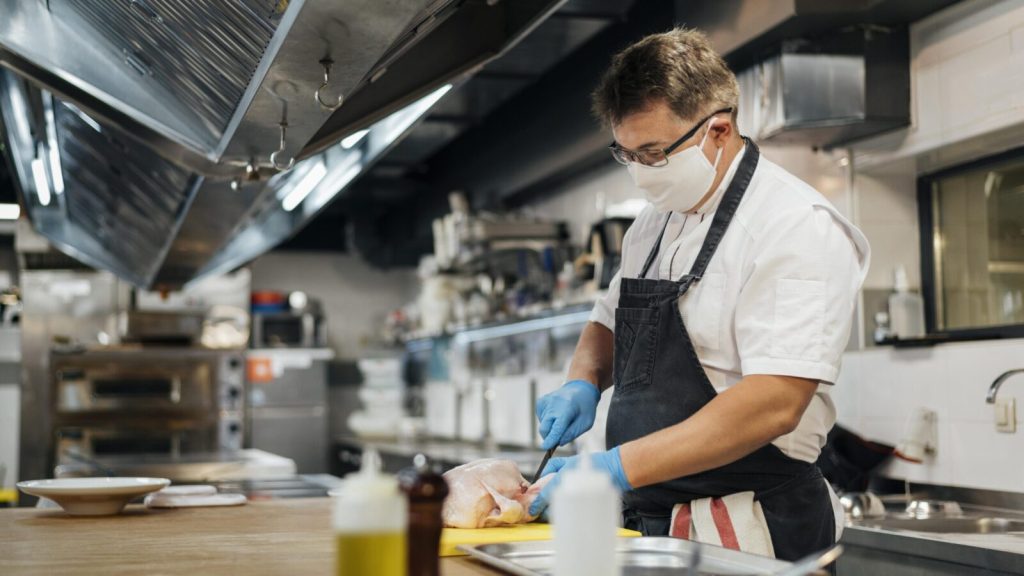
Essential PPE in the Food Industry: What You Need to Know
Overwhelmed by PPE options for food safety? Master your PPE selection for food workers safety with these practical tips.

Get 20€ off on your first order!
Construction sites are inherently dangerous environments, and the risks that workers face daily are significant. With construction accounting for a large proportion of workplace fatalities, reducing injuries on-site is a top priority. Fortunately, advances in safety protocols and the use of data-driven strategies have helped the industry make considerable progress. By identifying common hazards and implementing effective safety measures, construction companies can protect their workers and ensure a safer work environment.
Before starting a project, the building site should be checked for any strange or possible dangers. By being aware of these risks and how they might lead to certain accidents, you can make a good safety plan. A detailed risk assessment, which is sometimes called a “job hazard analysis,” has even been shown to save building projects money, lives, and even working capital. For every possible danger, a list of ways to keep it from happening should be made. After the risk assessment and the paperwork that goes with it should be shown to all workers during a safety meeting, they should get the right information, education, and training to keep them from getting hurt on the job.
A safety meeting every so often lets everyone know that the job itself is not the most important thing. Holding regular safety meetings is a good way to tell workers of the risks identified in the risk assessment. During these regular meetings, building companies often use “Toolbox Talks,” which are short, casual conversations about a specific safety problem. By focussing on a different issue each time, foremen can make sure that their teams are aware of all the different ways they could be hurt on the job.
Falls kill 33% of all building workers, making them the main cause of death in the field. Installing fall safety devices can keep a huge number of injuries from happening on your building site. The things that make up these systems are guardrails, toeboards, screens, nets, roof structures, and scaffolds. Finally, a safety harness or lanyard is another way to keep you from falling. We’ve written a full report about them here.
The machinery we use on building sites today is far more advanced than anything humans have ever been able to handle. This means that people have to spend a lot of time during their free time checking equipment and maintaining machinery. More than 75% of accidents from being hit happen from heavy machines like cranes or trucks. When you do regular, thorough maintenance checks on these huge machines, you greatly increase your chances of stopping problems that could hurt people before they happen.
You can only tell your employees so much and repeat knowledge; they are mostly responsible for what happens in real life. The ones with their boots on the ground are the ones doing the hard work. Because of this, an intentional safety mindset isn’t a choice; it’s a must. Creating a mindset of teamwork around safety will give your workers the willpower to avoid all injuries on the job site. Your workers will start to do their own risk assessments every time they go somewhere, follow safety rules with rigour instead of laziness, and avoid getting hurt by talking about it and being aware of it. This alone can lead to a building site with no injuries at all.
To minimise mishaps on construction sites, one must be attentive, ready, and take aggressive safety precautions. Building businesses that undertake detailed risk assessments, frequent safety meetings, discuss ways to prevent falling, maintain tools in excellent condition, and foster a culture of safety are far less likely to have accidents. Safety first not only protects workers but also increases general project success and output.
Thank you! You've signed up for our newsletter.



















Overwhelmed by PPE options for food safety? Master your PPE selection for food workers safety with these practical tips.

Struggling to maintain clear vision in demanding environments? This guide is here to help. By the end, you’ll know exactly...

Electricians across Europe face unique challenges that require reliable safety glasses to ensure both protection and efficiency. Whether safeguarding against...

Overwhelmed by PPE options for food safety? Master your PPE selection for food workers safety with these practical tips.

Struggling to maintain clear vision in demanding environments? This guide is here to help. By the end, you’ll know exactly...

Electricians across Europe face unique challenges that require reliable safety glasses to ensure both protection and efficiency. Whether safeguarding against...
Get 20€ off on your first order!
Save 30% by buying directly from brands, and get an extra 10€ off orders over €100
Save 30% by buying directly form brands, and get an extra 10€ off orders over €100